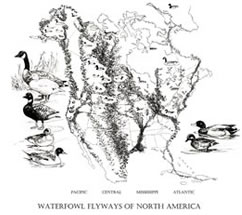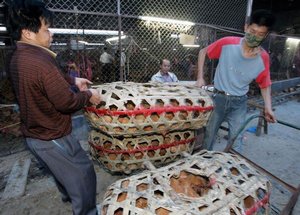Another view of Bird Flu

Have we got it right about bird flu? | |||||
| Disease/Infection News | |||||
| Published: Thursday, 8-Jun-2006 | |||||
| |||||
| |||||
| |
Haiti: One nurses perspective, one worlds help...

Have we got it right about bird flu? | |||||
| Disease/Infection News | |||||
| Published: Thursday, 8-Jun-2006 | |||||
| |||||
| |||||
| |

Jun 8, 2006 (CIDRAP News) – The US Centers for Disease Control and Prevention (CDC) yesterday released updated guidelines that provide more details on when to test a patient for the H5N1 avian influenza virus, as well as substantially more specifics on laboratory testing.
In the revised guidelines, the CDC also recommends that H5N1 avian flu surveillance in the United States remain the same, saying the epidemiology of human cases has not changed significantly since the agency issued recommendations on surveillance in February 2004. The guidelines are titled "Updated Interim Guidance for Laboratory Testing of Persons with Suspected Infection with Avian Influenza A (H5N1) Virus in the United States" (see link below).
The new guidelines recommend lab testing for a patient whose illness is associated with all of the following: (1) hospitalization or death; (2) a fever of 38°C (100.4°F) or higher; (3) radiographically confirmed pneumonia, acute respiratory distress syndrome, or other severe respiratory illness; and (4) potential exposure within 10 days of symptom onset.
The CDC lists potential exposure as any of the following:
In addition, the new guidelines recommend considering testing for a patient with: (1) mild or atypical disease (eg, respiratory illness and fever that does not require hospitalization, or significant neurologic or gastrointestinal symptoms in the absence of respiratory disease) and one of the exposures in the bulleted list above, or (2) severe or fatal respiratory disease whose epidemiologic information is uncertain, unavailable, or otherwise suspicious.
The new guidelines expand substantially on previous CDC guidelines, which called for testing for patients who have the radiographically confirmed severe respiratory illnesses listed above as well as a history of travel to a country where H5N1 infection has been documented. The previous guidelines called for considering testing for patients who have the same degree of fever listed above, as well as a cough, sore throat, or shortness of breath, and a history of contact with poultry or a known or suspected human case of H5N1 in an H5N1-affected country within 10 days of symptom onset.
The CDC update issued yesterday also provides greatly expanded recommendations for specimen collection and testing. They are condensed here:
The CDC update also reiterates that the public need not avoid travel to countries affected by H5N1. However, its advice remains that travelers to these countries should avoid poultry farms, bird markets, and other places where poultry is kept.
The agency also says that no evidence of reassortment between avian and human flu viruses has been found. However, the update states, "It is expected that human infections resulting from direct contact with infected poultry will continue to occur in affected countries." It adds, "This expanding epizootic continues to pose an important and growing public health threat."
See also:
Jun 7 CDC Health Update
http://www.phppo.cdc.gov/HAN/ArchiveSys/ViewMsgV.asp?AlertNum=00246

LOVELAND - In a cool, dry basement room, shelves full of canned food and hulking bags of flour and other staples act as Suzy Price's insurance policy.
It's a policy against a blizzard, flood, pandemic flu, even job loss.
The Church of Latter-day Saints advocates what it calls "provident living," or self-reliance, to protect against disaster.
As federal, state and local health officials urge America to stockpile two weeks' to two months' worth of food, medical supplies and emergency items in case of a flu pandemic, perhaps one caused by the H5N1 strain of bird flu, experts say the public can learn from people like Price.
She didn't outfit herself and her family in a day or a week or a month. She amassed what she estimates to be at least a year and a half of food supply over the course of years, buying 10 cans of cream of mushroom soup when it was on sale or a couple extra jars of peanut butter when the price was too good to pass up.
She buys only items her family eats anyway - tuna, peanut butter, canned peaches, cereal - and uses the oldest ones before they go bad, then replaces those with fresher products.
The government's http://pandemicflu.gov Web site urges families to stock two weeks of emergency items. Others, including Larimer County’s chief health official, suggest two months of supplies.
Some say supply lines could be cut or slowed during a pandemic as workers and truckers get sick; others say grocery stores could remain stocked during a flu pandemic, but people might not want to risk going out.
But pinning down how much food a two-week or two-month supply really is can be tough. It can also be an expensive stockpile to create in one trip to the store, not to mention an improbable one if hordes of others are trying to do the same.
For a better idea of how much food a family would need for two weeks or two months and how much it would cost, the Coloradoan built a day’s worth of meals using only nonperishable food that could be prepared without water or heat. The result was a 1,800-calorie-per-day diet that includes snacks of peanut butter and Powerbars to generate enough calories.
The canned food and drinks in the Coloradoan’s diet would cost about $20 per day for a family of four, assuming an average of 1,800 calories per person.
That’s about $280 for two weeks, or $1,200 for two months, of canned or other food that needs no preparation.
That’s more than many families can afford, which is why experts recommend a little-by-little approach.
Dr. Adrienne LeBailly, director of the Larimer County Department of Health and Environment, suggested families buy what they can, when they can. She compared the cost of stocking up to that of a family insurance policy.
“How much insurance do you want to buy for yourself and for your family?” she said.
Preparedness companies, including the Utah-based Nitro-Pak, offer emergency packs with enough food to last anywhere from three days to a year.
Nitro-Pak’s Ultimate-Pak Food Reserve, which the company says is enough food for four people for three months or one person for a year, costs about $4,000.
The company says there’s a three- to five-week delay on food orders because of bird flu worries.
Local officials say little help will come from federal or state agencies during a pandemic.
“Family preparedness, individual preparedness are the foundation for community preparation,” said Stephen Blois, director of Fort Collins Emergency Management.
“You don’t have to dump out the $1,200 to do it all at once. It’s like savings. You put a little in the bank and it adds up.”
With the thousands of dollars of canned food in Price’s basement, her most important investment might be in the one item the government also suggests not to get caught without — a can opener.
“I have five,” Price said.
Originally published June 9, 2006


The germ experts at LYSOL® believe that preparing, not panicking, about the Avian Flu is the best thing you can do for your family. Read through this five page article to learn how to prepare at home, school and work. You will find general preparedness information as well as links to your state government's plans. As a reference, click here to print our Avian Flu checklist—a short guide to prepare your family for a possible outbreak.






More Bird Flu Deaths Due To Human Transmission Experts Reconsider Cases But Say Virus Not Yet Pandemic
SAN FRANCISCO, Jun 5 | |
In the wake of a cluster of avian flu cases that killed seven members of a rural Indonesian family, it appears likely that there have been many more human-to-human infections than the authorities have previously acknowledged, Monday’s online edition of the San Francisco Chronicle informed. The numbers are still relatively small, and they do not mean that the virus has mutated to pass easily between people -- a change that could touch off a worldwide epidemic. All the clusters of cases have been among relatives or in nurses who were in long, close contact with patients. |